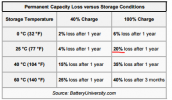- Joined
- Jan 26, 2019
- Messages
- 109
- Reaction score
- 25
Good day, pilots! I have an Evo. I have some doubts about the batteries since two appeared damaged without apparent reason. Batteries come with 6 days of time to discharge. What happens if days to discharge change for more or less days? For example, if it is changed to 3 days, battery's life is extended, time to recharge is shorten? Or vice-versa, if it is changed to 10 days? I do not understand what is the relation? Any tip for batteries care?
Thank you much!
Thank you much!





